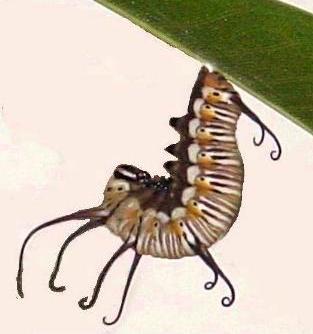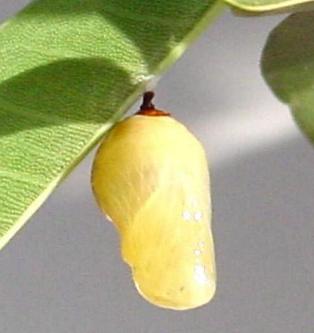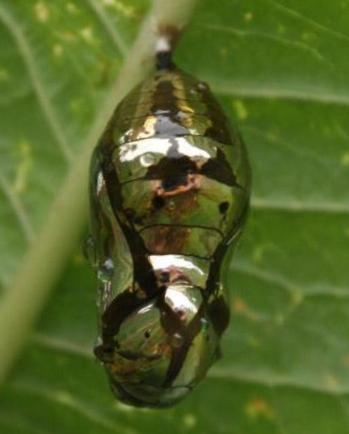
close-up of pupa
(Photo: courtesy of Andy Bowen, Noosa, Queensland)
This species is famous for its pupa.
The pupa is a shiny metallic silvery gold,
and is about two centimetres long.
It is usually found hanging from the underside of a leaf of its food plant.
The pupa in spite of its appearance is not metallic.
The shining effect is the result of of being covered in a number of
transparent layers of skin.
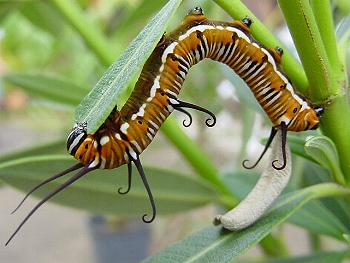
(Photo: courtesy of Coralie, aka Ferrous Angel)
The Caterpillar has alternating bands or orange,
black and white all along the body,
and has eight black tentacles in pairs:
two pairs on the
thorax,
and a pair on each of abdominal segments two and eight.
When disturbed, the caterpillar raises the front of its body,
and curls its head underneath.
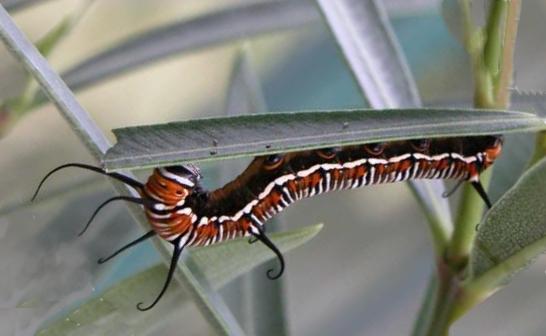
(Photo: courtesy of Russell Yates, Woodgate, Queensland)
The caterpillar is usually found on:
Oleander ( Nerium oleander,
APOCYNACEAE ).
The caterpillars have been found for many years on the Oleander
bushes along the main street of Newport in the northern
suburbs of Sydney, but curiously, not on similar bushes
along the adjacent side roads.
It is possible that the local Council,
in pruning the bushes back each year on the main road,
stimulated the growth of more suitable shoots
for the caterpillars to eat, than were available on the less
disturbed bushes in the side roads.
The caterpillar has also been found feeding on other plants in
APOCYNACEAE,
including:
Desert Rose (Adenium obesum),
Waxflower (Hoya australis),
Scented Milkvine (Marsdenia suaveolens),
Silkpod (Parsonsia straminea),
Cork Vine (Secamone elliptica),
and plants in
MORACEAE
including
Weeping Fig (Ficus benjamina),
Sandpaper Fig (Ficus coronata),
Morton Bay Fig (Ficus macrophylla),
Manbornde (Ficus virens),
The young caterpillars have
cannibal behaviour,
as they have been observed eating unhatched eggs
of their own species.
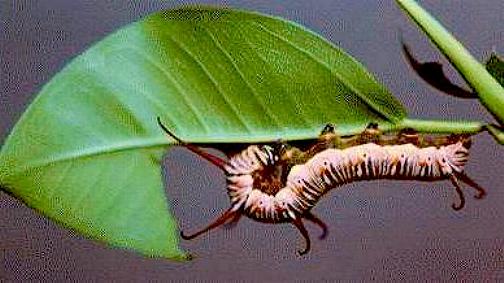
showing nibbled petiole
(Specimen: courtesy Joan Tyson, Bundaberg, Queensland)
At about mid-larval stage, an interesting feeding habit develops.
It is well illustrated at the extreme right-hand side
of the photo by Joan Tyson. Before starting to eat a new leaf,
the caterpillar first chews the underside
of its petiole until the leaf begins to sag.
It then eats the leaf.
It then repeats the procedure on subsequent leaves.
In summer in Sydney, the larval phase had lasts about 21 days.
The caterpillar grows to a length of about 6 cms.
the pupation process
About twelve hours after pupation,
the fully formed pupa is a rich creamy colour.
The silver phase occurs about a day later.
The pupal stage in summer in Sydney lasts about seven days.
On the morning of emergence, the pupa becomes almost black with
the pale legs of the adult lying bunched together on the abdomen and
some white blotches on the wing outlines.
After the adult emerges,
it takes about eight hours to fully expand its wings.
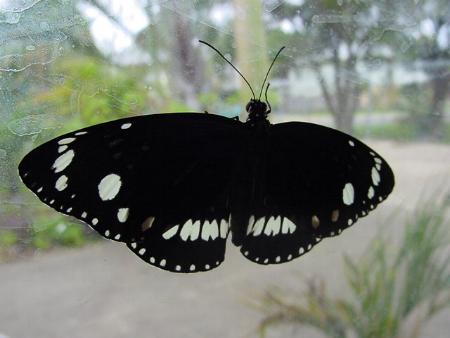
(Photo: courtesy of
(Photo: courtesy of Coralie, aka Ferrous Angel)
The adult butterflies have a wing span around 7 cms.
They are black with small white spots on the edges of the wings,
and larger spots further in. On the hindwings, these large spots
form a marginal row, and some spots are in pairs.
On the forewings, the large spots vary in size, and form a less
well defined row. In males, the
hind margin of the forewing is bowed;
in the female it is straight. The adults only have four legs.
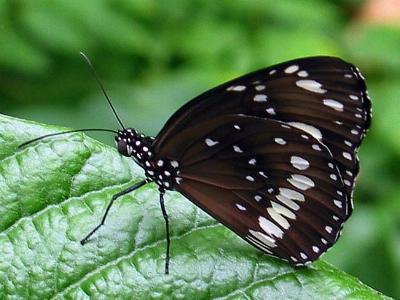
(Photo: courtesy of
Ian McMillan, Imbil, Queensland)
The adult butterflies sometimes
congregate in groups of thousands
at various sheltered coastal valleys from Brisbane to Townsville
to pass the winter in a state of hibernation.
The adult butterflies have been quoted as having a lifespan of
eleven to thirteen weeks.

(Photo: courtesy of
Todd Burrows, Blackbutt, Queensland)
The eggs are cream coloured and have a height of about 2 mm.
They are barrel shaped with ribs.
They are laid singly on the undersides of young leaves of the foodplant.
One of us has a Small-leafed Moreton Bay Fig Bonzai tree and
found a small white egg on one of the leaves on the 1st of January
one year. It hatched about one week later. and when its length reached
8 mm it was recognizable as the larva of Euploea core.
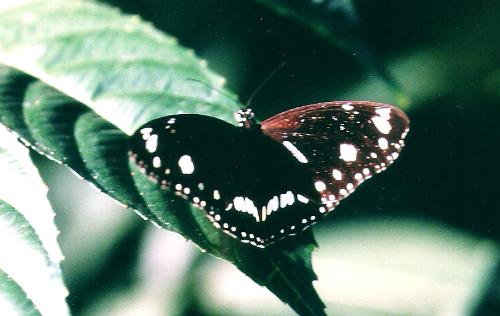
It seems to be a species that prefers a tropical climate.
It has been found in
New Caledonia,
Timor,
and the northern half of Australia including
Western Australia,
Northern Territory
Queensland,
Norfolk and Lord Howe Islands.
and occasionally spreads as far south as
New South Wales,
Australian Capital Territory,
Victoria and
South Australia.

Cocos Islands 1982
The adult butterflies are sometimes found
sucking the sap from the fruits of
Rattlepods ( Crotalaria species).
The butterflies are thought to absorbing poisons from the plant
in order to, in turn, make themselves poisonous to eat.
The species is featured at the
Coffs Harbour Butterfly House.
Butterflies of this species may be
purchased in Australia for release at weddings etc.
For many years, Euploea corinna was though to be a subspecies of
Euploea core,
but Vane-Wright (1993) found stable populations of both species side-by-side
on Bali and adjacent islands, proving that they were separate species.
Further reading :
Michael F. Braby,
Butterflies of Australia,
CSIRO Publishing, Melbourne 2000, vol. 2, pp. 605-607.
Frank Jordan & Helen Schwencke,
Create More Butterflies : a guide to 48 butterflies and their host-plants
Earthling Enterprises, Brisbane, 2005, pp. 14, 62.
William Sharp Macleay,
Annulosa,
in Philip Parker King :
Narrative of a Survey of the Intertropical and Western Coasts of Australia,
Volume 2 (1826), Appendix B, p. 462, No. 150.
Buck Richardson,
Tropical Queensland Wildlife from Dusk to Dawn Science and Art,
LeapFrogOz, Kuranda, 2015, p. 224.
(updated 18 February 2013, 13 October 2025)
9 October 2021)





